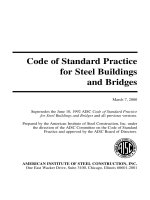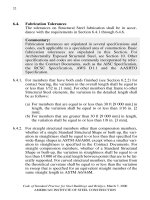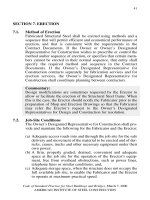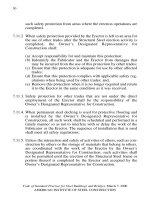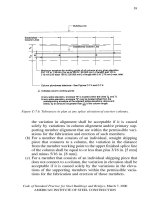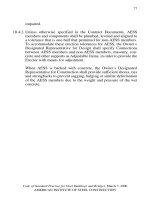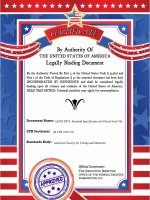ASTM D29091a Standard Practice for Bituminous Mixing Plant Inspection (Withdrawn 2000)
Bạn đang xem bản rút gọn của tài liệu. Xem và tải ngay bản đầy đủ của tài liệu tại đây (534.66 KB, 6 trang )
ASTM D290 R E V * A 91 m 0759530 0080707 2
NOTICE: This standard has either been superseded and replaced by a new version or discontinued.
4[Tb Contact ASTM International (www.astm.org) for the latest information.
Designation:D 290 - 91a AMERICAN SOCIETY FOR TESTING AND MATERIALS
1916 Race S t Philadelphia, Pa 19103
Reprintedfrom the Annual Book of ASTM Standards. Copyright ASTM
If not listed in the current combined index, will appear in the nexi edition.
Standard Practice for
Bituminous Mixing Plant Inspection’
This standard is issued under the fixed designation D 290; the number immediately following the designation indicates the year of
original adoption or, in the case of revision, the year of last revision. A number in parentheses indicates the year of last reapproval. A
superscript epsilon (e) indicates an editorial change since the last revision or reapproval.
1. Scope 3.1.3 Contractor, n-the party to the contract who has
agreed to supply materials and perform work in accordance
1.1 This practice defines the authority and duties of the with the specifications, or the contractor’s duly authorized
inspector at the bituminous mixing plant. These duties are representative at the plant.
performed in order to ensure the contractor’s compliance
with the contract and applicable specificationsand do not in 3.1.4 laboratory, n-any supervising laboratory duly au-
any way relieve the contractor of the responsibility to thorized by the engineer to direct and advise the inspector in
produce uniform mixtures in compliance with the contract. the discharge of assigned duties.
1.2 The values stated in inch-pound units are to be 3.1.4.1 Discussion-The laboratory shall satisfy the appli-
regarded as the standard. cable requirements of Practice D 3666.
1.3 This standard does not purport to address all of the 3.1.5 plant laboratory, n-the laboratory operated by or
under the direction of the plant inspector at the plant, or the
safety problems, if any, associated with its use. It is the contractor’s laboratory for use by the contractor’s represen-
tative for the control of plant production.
responsibility of the user of this standard to establish appro-
priate safety and health practices and determine the applica- 4. Significance and Use
bility of regulatory /imitations prior to use.
4.1 This practice defines the authority and duties of the
2. Referenced Documents inspection personnel assigned to bituminous mixing plants.
2.1 ASTM Standards: 4.2 The intent of the practice is to assure by inspection,
C 136 Method for Sieve Analysis of Fine and Coarse that the contractor’s facilities, production operations, mate-
rials handling, required testing, and finally, the finished mix
Aggregates2s3 product comply with applicable specifications.
D 75 Practice for Sampling Aggregates)
D 140 Practice for Sampling Bituminous Materials3 5. Responsibilities and General Duties of Inspector
D 242 Specification for Mineral Filler for Bituminous
5.1 Authority-In the absence of authority conferred by
Paving Mixtures3 the specifications or contract provisions, the inspector shali
D 546 Test Method for Sieve Analysis of Mineral Filler for be provided with written authority from the engineer to
ensure fulfillment of specifications covering materiais, plant
Road and Paving Materials3 procedure, and products, and reject such materials, proce-
D 979 Practice for Sampling Bituminous Paving Mixtures3 dures, and products failingto conform to specifications.The
D 995 Specification for Mixing Plants for Hot-Mixed, inspector shall have availablea copy of the specificationsand
any contract special provisions applying to the particular
Hot-Laid Bituminous Paving Mixtures3 project, and shall be furnished immediately in writing with
D 3666 Practice for Evaluating and. Qualifying Agencies copies of all modifications, amendments, and instructions
affecting the product of the plant. The inspector shali
Testing and Inspecting Bituminous Paving Material9 recognize the right of the contractor to use such apparatus,
methods, and personnel as deemed proper, provided that no
3. Terminology specification requirements are thereby violated. Any appeal
on the part of the contractor from rejections shall be made in
3.1 Descriptions of Terms Specific to This Standard: writing to the engineer, with a copy to the inspector, unless
3.1.1 engineer, n-the party in responsible charge of the otherwise provided in the contract.
work or the engineer’s duly recognized or authorized repre-
sentative. 5.2 Cooperation-The plant inspector shall cooperate
3.1.2 inspector, n-the engineer’s (or in the absence of the with the contractor in every reasonable way to obtain
engineer, the purchaser’s) authorized representative dele- efficient and economical plant operation consistent with
gated to perform inspections, tests, and duties hereinafter production of a mixture of satisfactory quality, and with the
indicated. paving inspector on matters of mutual concern relating to
3.1.2.1 Discussion-The inspector shall be qualified as a obtaininga mixture of satisfactoryplacement characteristics,
technician in accordance with the applicable requirements of ail within the limits of the specifications.
Practice D 3666.
5.3 Duties-In addition to the responsibilitiesspecified in
I This practice is under the jurisdiction of ASTM Committee D-4 on Road and 5.1 and 5.2, the duties of the plant inspector shall be:
Paving Materials and is the direct responsibility of Subcommittee W4.23 on
Plant-Mixed Bituminous Surfaces and Bases. 5.3.1 To ensure that the plant is equipped and operated at
all times in conformity with the specifications (Section 6),
Current edition approved Sept. 15, 1991. Published November 1991. Originally
published as D 290 - 28 T.Last previous edition D 290 - 9 I .
Annual Book of ASTM Standards, Vol 04.02.
Atinual Book of ASTM Standards, Vol 04.03.
1
A S T M D290 R E V * A 91 H 0 7 5 9 5 3 0 0080708 4 9
Material Method TABLE 1 Index of Sampling When Collected BYWhom Tested
Fine aggregate (cold feed) Practice D 75 Quantity preliminary or first shipments from laboratory or piant
Coarse aggregate (wid Same as for Fine Aggregate Case IA-25 Ib (11.3 kg) given source and when source of laboratory
feed) Specification D 242 Case ilB-5 ib (2.3 kg) supply changes, when material
characteristics change, or by laboratory or plant
Filler Case IA-50 ib (22.7 kg) cpeciai instructions from engineer laboratory
Case ilB-50 ib (22.7 kg) laboratory or piant
5 ib (2.3 kg) same as for fine aggregate
laboratory
each shipment plant laboratory
Aggregates (plant bins) By use of approved sampling 5 (2.3 kg) to 35 Ib (15.9 kg) or at least daily plant laboratory
device capable of obtaining a more depending on maximum laboratory
particle size as required under each car, tank truck, or boat
representative bin sample Method C 136 A. Daily laboratory
B. As directed
Bituminous material Practice D 140 1 qt (1 L)
Practice D 979
Finished mixtures: Practice D 979
A. To determine aver- Practice D 979
age daily analysis 1 square piece of size specified as directed
of mixture. by Practice D 979
B. For determination of
uniformity of indi-
vidual or different
batches
Pavement sample
A When job-mix is formulated by Laboratory.
When job-mix is formulated by Contractor.
5.3.2 To obtain samplesas required for testing at the plant in Table 1, Index of Sampling.
laboratory or submission to the laboratory (Section 7), 7.1.2 As far as possible in advance, but within the time
5.3.3 To inform the contractor when mixture or condi- limitation imposed by contract requirements, representative
tions violate specifications and disapprove subsequent pro- samples of each material proposed for use in the bituminous
duction if corrections are not made (Section 8), mixture shall be obtained by, or under approval and obser-
vation of, the inspector and submitted to the laboratory or
5.3.4 To conduct tests to check the adequacy of ( I ) tested by the inspector as directed.
materials to be used in mixture production and (2) plant
control in maintaining a mixture which is in conformance NOTE1-Requirements for lead time, she of samples, and specific
with the job-mix formula and tolerance limits for uniformity sampling procedures will vary with contracting agencies, for example,
(Section 9), different conditions will prevail as between job-mix formulation by the
contractor or the engineer,
5.3.5 To maintain required inventory and production
records (see 10.i), and 7.1.3 Should the source of supply of any material, or the
characteristics of any material affectingspecificationrequire-
5.3.6 To submit daily reports (see 10.2 and 10.3). ments change from that represented by the initially sub-
mitted samples, new samples shall be submitted to the
6. Plant Equipment and Operation laboratory by the inspector.
6,l General requirements for plant equipment shall be 7.1.4 Daily control samples of bituminous material and
determined in accordance with Specification D 995 and mixtures shall be collected and, at the end of the day’s work,
supplementingcontract requirements. forwarded to the laboratory without delay.
6.2 The inspector shall ascertain as early as possible, by a NOTE2-When forwardingsamplesof crude asphalt, refined asphalt,
thorough inspection of the plant site, plant, and appurte- hard natural asphalt, oxidized asphalt or any other bituminous materials
nances, that all elementsare in compliancewith the contract. in inspectionscovering the production of bituminous pavementsincor-
Specific attention shall be given to materials storage and porating such materials, information shall also be furnished relative to
handling, cold aggregate feeds, drier, mixture production the proportions by mass being used so that proper combinations can be
plant, batching and mixing components, truck scales (when made for analysis and check determinations.
required), and hauling units. The inspector shall witness
checks on the accuracy of the scales, using standard weights, 7-2 Bituminous Mixtures:
and of volumetric meters if used in the proportioning of 7.2.1 Samples of bituminous mixtures shall be taken by
mixtures. During the operation of the plant, a periodic check the contractor daily, or as directed, and witnessed by the
shall be made on the accuracy of scales or meters used in inspector for the purpose of checking average aggregate
determining the mass or volume of each component mate- grading, and if desired, bituminous material content of the
rial. produced mixture by means of extraction procedures. Sam-
ples may also be taken, if directed, to determine uniformity
7. Sampling within a batch, or batch-to-batch (time-to-time for contin-
uous mixing plants),
7:1 Materials (General): 7.2.1.1 In the case of plants automaticallyrecording batch
7.1.1 A recommended schedule of sampling is indicated
2
ASTM D290 R E V * A 91 0759510 0080709 b
4m D290
mass of aggregate and the bituminous material, the engineer rates between aggregates, and make certain that feeding is
may elect to check bituminous material content of the continuous and uniform, especially with fine aggregates of
mixture on the basis of batch mass, or comparison of actual high moisture content.
versus theoretical consumptions, instead of extraction tests
on samples of produced mixture. 8.3 DryingAggregates-The inspector shall make certain
that the aggregate is properly dried and heated to the desired
7.2.2 Sampling of bituminous paving mixtures shall be temperature, and that the feed of aggregates to the dryer is
done in accordance with Practice D 979, except as modified consistent with the capacity of the dryer at the given
below, for determination of within batch variation.
moisture content.
7.2.3 Composite Sample-Samples obtained for the pur- 8.4 Proportioning by Mass:
pose of checking aggregate grading and bituminous material 8.4.1 The inspector shall witness a check on calibration
content shall be composited by accumulating fractions from
occasionalbatches produced during the day, or shorter check and accuracy of batching scales, initially and periodically
interval, and stored on a metal plate or in another suitable thereafter (at least weekly or when suspect). The batching
container. The sample, of a size required for testing, shall be operation should be observed frequently (continuouslywhen
obtained from the accumulated fractional samplings by feasible or required) to determine that proper care is being
quartering after thorough remixing.-To facilitate remixing,
the entire mass should be warmed, avoiding overheating to exercised in weighing batches, that aggregate hoppers and
the degree necessary to permit satisfactory mixing. bitumen bucket swing freely during weighings, and that the
mass indicators read zero after discharge of the batch. The
7.2.4 Uniformity Samples-Samples used to determine inspector should observe that the bitumen bucket is drained
uniformity within a single batch or from batch to batch shall completely for each batch and check the tare mass of the
be obtained as follows: empty bucket at frequent intervals to determine if any
compensation should be made for the amount of bituminous
7,2.4.1 With Batch Variation-Individual samples shall materia1 clinging to it. (This latter element requires more
be taken by means of a sampling thief from three uniformly attention in cool weather or at timtwwhen there is.a long
separated locations in a single batch and individually interval between loads.)
analysed.
8.4.2 The inspector shall make certain that the aggregates
7.2.4.2 Batch to Batch Variation-Samples shall be taken are deposited in the mixer in a proper sequence for satisfac-
from three or more separate batches throughout a day?s tory mixing, that the specified dry-mixing and wet-mixhg
production by Practice D 979, and remixed, quartered, and
analysed separately. periods are accomplished, and that the mixing time is
sufficient to produce a homogeneous mixture of uniform
7.2S All sampling of mixtures shall be done with extreme color and texture.
care to assure representativenessand to preclude contamina-
tion with foreign material. Samples submitted to the labora- 8.5 Proportioning by Volume:
tory should be completely identified and accompanied with 8.5.1 Aggregate Feed-The inspector shall witness the
required data. ?calibration? of the hot-bin and mineral filler feeders at
various gate openings or control-arm settings, and check the
7.3 Rejected Materials-Samples of all materials rejected contractor?s computations for and plot of the calibration
by the inspector may be forwarded to the laboratory. graphs relating to volume flow of aggregate from the respec-
tive bins to pounds delivered per revolution of the feeder
7.4 Marking Samples-Beginning at the start of opera-
tions on a given contract, the inspector shall assign class mechanism.
8.5.2 Bituminous Material Feed-The inspector shall
designations to each class of material being sampled, and
witness a check on the bituminous material pump delivery
each sample selected shall be numbered serially in that class, per revolution of the aggregate feeder mechanism (con-
continuing numerically until the completion of the work. tinuous mixing plant) or accuracy of the batch meter
Care shall be taken that the series of numbers is not broken
or numbers duplicated. All samples sent to the laboratory (Volumetrie metering batch plant).
shall be marked in such a manner as to ensure complete 8.5.3 Batch Proportions-The contractor?sbatch propor-
identification. Letters and numbers may be scratched or
punched clearly on tin cans, and marked with ink or paint tions per revolution shall be subject to the approval of the
on other sample containers or on sections of pavement. inspector to assure compliance of the bituminous mixture
with the job-mix formula.
8. Preparation of Mixtures
8.6 Mixtures (General):
8. I Job-Mix Formula-The inspector shall receive in- 8.6.1 The inspector shall ascertain that the aggregates in
structions from the engineer with regard to the job-mix the hot bins are of known and uniform gradation so they
formula establishing the percentage of bituminous material may be batched in the prescribed proportions and consis-
(in relation to either the total mixture or aggregate fraction) tently produce a mixture within specification limits of
and aggregate gradation, and the specification tolerance tolerance.
limits for deviation in either bituminous material content or 8.6.2 The inspector shall make periodic visual observa-
gradation of the produced mixture from the job-mix values. tions of the produced mixture to ensure homogeneous
8.2 Combining Cold-Feed Aggregates-The inspector batches of continuously uniform color and texture.
shall check to assure that proper attention is given to the 8.6.3 When bituminous material is batched by volume, its
combining of aggregates before they enter the dryer. Settings
of feeders should be noted as established by the contractor, mass per gallon, at operating temperature, shall be deter-
any changes in settings which will change the relative feed mined and the batching meter adjusted to deliver the
required volume at this temperature.
8.6.4 It is recommended that, whenever possible, entire
3
A S T M D290 R E V * A 93 9 0759530 O080730 2 9
4m D290
loads of the mixture proportioned either by mass or volume, daily plant report. The results will show: ( I ) when blended
be weighed as a check against individual batches. materials are being used, whether cold-feed blending is being
carried on satisfactorily and ( 2 ) whether separation of
8.7 Temperature of Materials and Mixtures: aggregates by sizes has been uniform. If the screened fine
8.7.1 The inspector shall check the temperature of all aggregate bin is contaminated with coarse aggregate or the
ingredients of the mixture, especially mineral aggregates,and
of the mixtures as frequently as possible. The inspector shall screened coarse aggregatebins contain an excessivechange in
assist in keeping temperatures uniform by notifyingthe plant the amount of fine material carried over from the next finer
foreman of any marked changes observed. In the event of bin, steps shall be taken to determine the cause and to make
improper temperature, mixing operations shall be discon- correction.
tinued until aggregates of the proper temperature are ob-
tained. 10. Report
8.7.2 The desired temperatures at the plant will depend
upon the kind of mixture being prepared, the type of 10.1 Production of Pfunt-The inspector shall maintain a
bituminous material being used, weather conditions, and the
length of haul. The inspector should, therefore, receive daily record of (i)time and hours of plant productioq, ( 2 )
instructions from the engineer as to the temperatures appli-
cable under the various conditions. number of batches (or tons) of the various mixtures pro-
9. Plant Testing of Materials duced, (3) the batch mass proportions of hot-bin aggregates
9.1 Filler-A minimum of one thoroughly dry sample of and bituminous material, and ( 4 ) when possible, a balance
filler, representing each shipment received at the plant, shall
be tested in accordance with Test Method D 546. sheet comparison of bituminous materials actually used
9.2 Cold Aggregates-Fine and coarse aggregate shall be (based on receipts, disbursements, and tank inventories) and
tested in accordance with Method C 136. Samples shall be
tested daily, or more often if necessary, in order to provide theoretically used (based on number of batches produced
data for making adjustments to the combination of aggre-
gates at the cold-feed to the dryer. When two or more multiplied by quantity per batch). Other miscellaneous
aggregates are being received for use in combination, sepa-
rate sieve analysis shall be made on each aggregate and the information shall be recorded as required to complete
required combination to meet the job-mix gradation calcu-
lated and shown on the daily report. The proportions in specific report forms.
which all aggregates, including added filler, are combined in
the batch shall also be shown on the report. 10.2 Daily Reports-At the close of each working day,
9.3 Heated Aggregates: whether the plant is in operation or not, the inspector shall
9.3.1 Samples of aggregates as discharged from the hot
storage bins into the mixer shall be taken and tested at least forward to the engineer and laboratory a consecutively
twice during a full day's operation, or more frequently if
necessary, in order to determine the uniformity and grada- numbered daily report, using a form which gives all the
tion suitability of bin materials to maintain the mixture
within tolerance limits. Samples shall be secured from the required information. All data pertinent to the work not
stream of aggregate as it flows from the storage bin by any
means which provides a truly representative sample of the covered by the form should be given on the reverse side of
material in the bin.
9.3.2 All tests of these materials shall be recorded on the the report sheet, and communications of exceptional impor-
tance only should be sent separately from the report. When
work is suspended for several days, the inspector may not be
required to submit reports daily, but the last report should
state why and for what periods work has been discontinued.
The inspector shall retain copies of these reports and
communications and, in addition, keep a daily record of all
matters pertaining to the work inspected, particularly as to
any action in the acceptance or rejection of materials with
reasons therefore, instruction or suggestions to the con-
tractor, and the receipt of instructions from the engineer or
,
laboratory,
10.3 Report Form-A standard form of report is not
practicable for all conditions and types of pavement, but the
report form shown in Table 2 is a typical form showing the
kind of information which should be included; additional
data may be called for as required.
4
ASTM D290 R E V * A 91 W 0759530 0080713 4 m
TABLE 2 Bituminous Mixing Plant Inspector's Daily Report
NOTE: This report is intended as a guide. When more materials are being used, or more than one mix type is being produced, additional spaces may be necessary.
Project county State Date
Bituminous Mixture:
Report No
TypeIGrade Source Continous-Batch Mix Time Per Batch Seconds
Component Materials Date Received Amount
Car or Truck Number
Bitumj ous
Materia?
I I Source I 21h in. I IVz in. I I in. 1 3h in. I 'h in. I 318 in. I No. 4 I No. 8 INo. 16 I No. 30 I No. 50 INo.IMINO. 200II i
Aggregate TY w I IIII I IIIIII I l
Coarse
Intermediate l I IIIIII I1 I I I I I
I I I I I I I I I l I I I I I
Cornbiped Coarse % ' Fine -%
Gradaiion I n t e r m e ~-%e Fil%ler ,
Job Mix
Formula
Analysis of Hot Bin Aggregates
Sand Equivalent Value Correction Factor From Washed Analysis (No, 200) -
Mix Type Batch Weights, Ibs, or Ibs Der revolution
Total Mix, %
Bin 1 Bin 2 I Bin 3 I Bin 4 l Filler l Bituminous Material l Total
I
Analysis of Mix
Temperature of Mix, 'F
'Faren heit I I I I I I l I I I I
~ ~~ ~ Cohesionmeter
Value
Characteristicsof Mix Stability
Sample Time or Theoretical S cimen Theoretical Rpw
Location Load No. Density Ensity Density, % .O1 inch
From Truck
From Truck I I I l I I I ___
p.m. ~ ~~
Weather: a.m. p.m Temperature: a.m.
Plant Operated: Tons Previous Production: Type of Mix:
From.
To Tons Today
Tons Total
Sample No Represents Tons o f Surỵac- For Dates
Sample No For Dates
Remarks Represent- Tons o f Surfac-
Plant Inspector, Resident Engineer, etc.
Signed
5
A S T M D290 R E V * A 93 W 0759530 0080732 b
4m D290
TheAmerican Society for Testingend Meteriais tekes no position respecting the veiidity of any patent rights asserted in connection
with any item mentioned In thls stenderd. Users of this stenderd ere expressly edvised that determination of the velldity of eny such
Petent rights, and the risk of infringement of such rights, are entirely their own responsibility.
This stendard is subject to revision et any time by the responsible technlcei committee and must be reviewed every five yeers end
if not revised, either reepprovedor withdrawn.Your comments are invited either for revision ofthis standard or for additional standards
and should be addressed to ASTM Headquarters. Your comments wlll receive careful consideration at e meeting of the responsible
technical committee, which you may attend. If you fee/ that your comments have not received a fair hearing you should meke your
views known to the ASTM Committee on Stenderds, 1916 Rece St., Phiiedeiphie, PA 19103.
6
